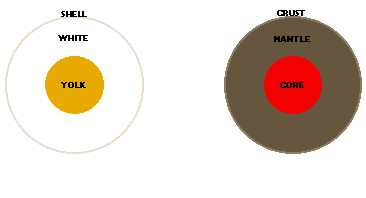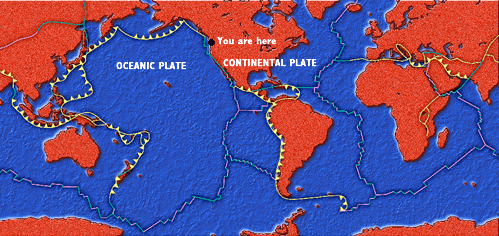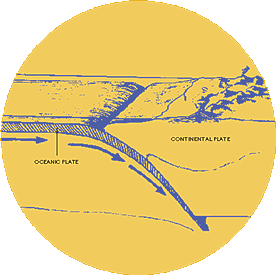EARTHQUAKES SHAKE US UP!
Earthquakes shake us up, but theyre as natural
as rain. Theyve raised up Northwest mountains over millions
and millions of years. What causes earthquakes? Its the constant
motion of the earths crust.
Earthquakes Are Inevitable
Earthquakes are the result of the structure of our planet. The
earth beneath us is rock all the way through, but only the thin
crust is a brittle solid. Inside the earth, the rock is so softened
by heat that it slowly moves and flows.
|
The Earth is like an egg
The inside of the earth is layered something like an egg.
Both have a thin, brittle shell. The crust of the earth is
broken into pieces, like the cracked shell of a hardboiled
egg. The mantle of the earth is like the egg white, and the
core of the earth lies in the center, like the egg yolk.
|
 |
 |
Not as solid as it seems
The earths brittle crust is broken into pieces that
geologists call plates.
These plates are in constant slow motion, carried by currents
in the earths heat-softened interior. These convection
currents move at about the speed that our fingernails grow.
What are convection currents?
If youve ever watched a lava lamp, youve seen
convection currents at work.
- Heat (from the light bulb) warms up a colored liquid at
the base of the lamp.
- The colored liquid rises, because hot liquids are less
dense than cool ones.
- As the blobs of hot liquid move away from the heat source,
they cool off, become more dense again, and sink back to
the bottom. This cycle of movement is called a convection
current.
|
|
Heat keeps plates in motion
The earth is something like a lava lamp. Inside the mantle,
convection currents rise slowly, fueled by heat in the earths
core. Most of the earths heat is left over from the
Big Bang at the formation of the Universe. Ongoing radioactive
decay constantly produces more heat.
The convection currents within the earth are huge. They carry
the crust plates along with them, because the crust is so
thin in comparison.
Convection currents circulate slowly within the earths
mantle.
|
 |
Plate motion makes earthquakes
All the plates that make up the crust are jostling against each
other. Strain builds up as these plates of solid rock grind together.
Eventually the rocks cant take it any more. The plates slip
and the built-up stress is suddenly released as an...Earthquake!
Because of the jostling of the plates, earthquakes usually happen
at plate edges.
Motion is at the margin
The Pacific Northwest lies on the margin of the North American continental
plate. Just off the coast, a dense oceanic plate is slidingsubductingbeneath
us. These plate motions are continuous, and so earthquakes are inevitable.
 |
The earth has
plates
Earths crust is composed of eight large plates and a number
of small ones. Strings of triangles and lines show the edges
of crustal plates. |
YOU ARE HERE detail:
At the edge of the Pacific Northwest, an oceanic plate is sliding
(subducting) beneath a continental plate. |
 |
Next Page
|

